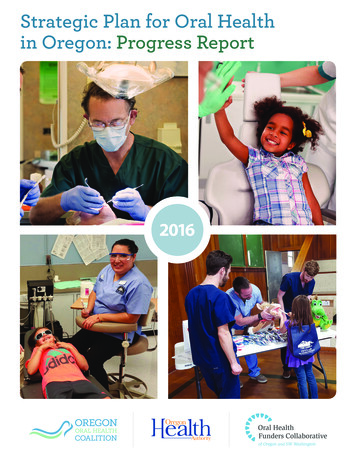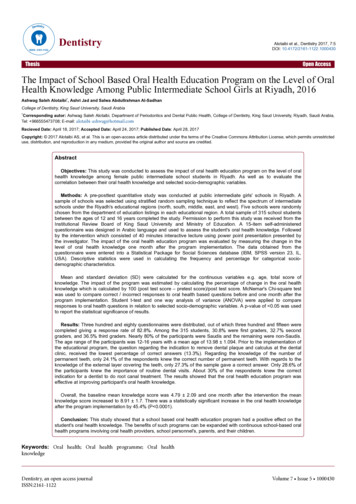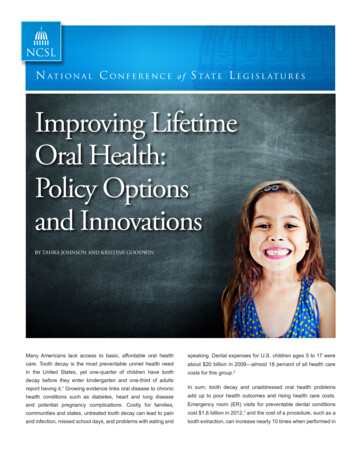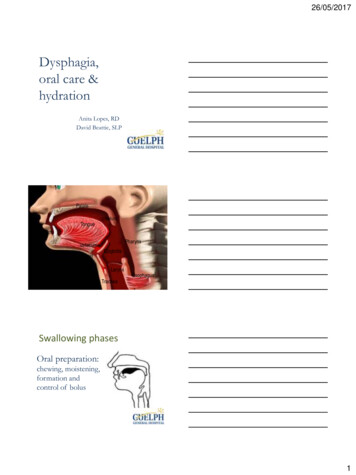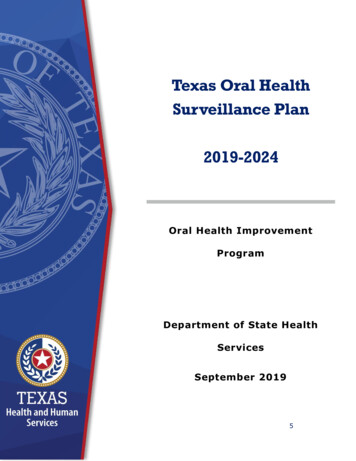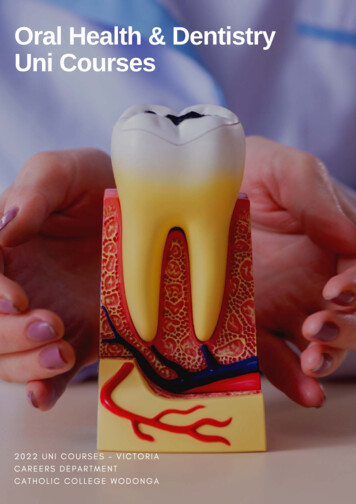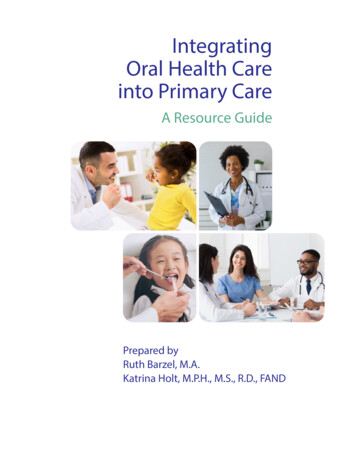
Transcription
IntegratingOral Health Careinto Primary CareA Resource GuidePrepared byRuth Barzel, M.A.Katrina Holt, M.P.H., M.S., R.D., FAND
Cite asBarzel R, Holt K, eds. 2020. Integrating OralHealth Care into Primary Care: A ResourceGuide. Washington, DC: National Maternal andChild Oral Health Resource Center.Integrating Oral Health Care into Primary Care:A Resource Guide 2020 by National Maternaland Child Oral Health Resource Center, Georgetown UniversityThis publication was supported by the HealthResources and Services Administration (HRSA) ofthe U.S. Department of Health and Human Services (HHS) as part of an annual award totaling 1,000,000 with no funding from nongovernmental sources. This information or content andconclusions are those of the author and shouldnot be construed as the official policy of HRSA,HHS, or the U.S. government, nor should anyendorsements be inferred.Permission is given to photocopy this publicationor to forward it, in its entirety, to others. Requestsfor permission to use all or part of the information contained in this publication in other waysshould be sent to the e-mail address below.National Maternal and Child Oral HealthResource CenterGeorgetown UniversityE-mail: OHRCinfo@georgetown.eduWebsite: www.mchoralhealth.org
ContentsIntroduction. . . . . . . . . . . . . . . . . . . . . . . . . . . . . . . 3About This Guide. . . . . . . . . . . . . . . . . . . . . . . . . . . 5Acknowledgments. . . . . . . . . . . . . . . . . . . . . . . . . . 6Materials. . . . . . . . . . . . . . . . . . . . . . . . . . . . . . . . . . 8Data and Surveillance. . . . . . . . . . . . . . . . . . . 8Policy. . . . . . . . . . . . . . . . . . . . . . . . . . . . . . 10Practice Guidance. . . . . . . . . . . . . . . . . . . . . 15Practice Tools. . . . . . . . . . . . . . . . . . . . . . . . 20Professional Education and Training . . . . . . . 22Program Development (National Efforts). . . . 26Program Development (State Efforts). . . . . . . 29Organizations. . . . . . . . . . . . . . . . . . . . . . . . . . 33
Introductiontremendous possibilities for integrating oral healthcare and primary care and improving patientcentered care.5 In addition to these federal reports,many organizations have developed resources tosupport the integration of oral health care into primary care. The focus of primary care for pregnantwomen, infants, children, and adolescents includesfamily medicine, pediatrics, and obstetrics andgynecology.In 2000, Oral Health in America: A Report of theSurgeon General emphasized that oral healthis integral to overall health and should not beviewed as separate from overall health.1 Sincethen, several federal reports have highlightedintegrating oral health care into primary care asa promising strategy to expand access to oralhealth care and reduce health inequities; improvecare coordination, health outcomes, and patientsatisfaction; and reduce health care costs. The2011 Institute of Medicine reports, AdvancingOral Health in America and Improving Access forOral Health for the Vulnerable and Underserved,recommended that the Health Resources andServices Administration (HRSA) address the needfor improved access to oral health care throughthe development of a core set of oral healthcompetencies for non-oral-health professionals.2,3In response, HRSA released Integration of OralHealth and Primary Care Practice, which providesinterprofessional oral health core clinical competencies to facilitate change in the clinical practiceof primary care health professionals working insafety net settings.4 This document was followedby the release of the U.S. Department of Healthand Human Services Oral Health Strategic Framework 2014–2017, which asserts that interprofessional education and collaborative practice presentYoung children are seen by primary care healthprofessionals more often than by oral healthprofessionals. It is recommended that infants andchildren have 12 preventive pediatric health care(well-child) visits in the first 36 months of life andan annual well-child visit between ages 3 and 21.6During these visits, health professionals frequentlyconfront morbidity associated with dental caries.7Well-child visits offer an opportunity to integrateoral health care (e.g., risk assessment, screening,preventive intervention, anticipatory guidance andcounseling, referral to an oral health professional)into pediatric health care. Such integration, inturn, can increase access to oral health services,thereby improving oral health.8 With early referralto an oral health professional, there is an opportunity to maintain good oral health, prevent oraldisease, and treat oral disease early. EstablishingI N T E G R AT I N G O R A L H E A LT H C A R E I N TO P R I M A R Y C A R E : A R E S O U R C E G U I D E3
collaborative relationships between primary careprofessionals and oral health professionals at thecommunity level is essential for increasing accessto oral health care for all children and for improving their oral health and overall health.7nurse midwives) are often first to assess pregnantwomen’s health, they play a critical role in connecting women with the oral health care systemand community-based programs.10 These professionals can integrate oral health care (e.g., riskassessment, screening, preventive intervention,anticipatory guidance and counseling, referralto an oral health professional) into primary carevisits, thereby increasing women’s access to oralhealth care during the perinatal period.11Pregnancy is a unique period during a woman’slife and is characterized by complex physiologicalchanges, which may adversely affect oral health.Access to preventive oral health care is essentialfor pregnant women to have the best possible oralhealth and overall health. In many states, pregnantwomen with low incomes are eligible for Medicaid dental coverage that they don’t have duringother periods of their lives.9 Since non-oral-healthprofessionals (e.g., obstetricians, family physicians,Integrating oral health care into primary care is akey strategy for improving access to oral healthcare and oral health, especially for vulnerable andunderserved groups that face barriers to accessingthe oral health care system.References7. Section of Oral Health. 2014. Maintaining andimproving the oral health of children. Pediatrics134(6):1224 –1229.1. U.S. Department of Health and Human Services.2000. Oral Health in America: A Report of the Surgeon General. Bethesda, MD: National Institute ofDental and Craniofacial Research.8. Kranz AM, Rozier RG, Stein BD, Dick AW. 2020.Do oral health services in medical offices replacepediatric dental visits ? Journal of Dental Research99(8):891– 897.2. Institute of Medicine, Committee on an Oral HealthInitiative. 2011. Advancing Oral Health in America.Washington, DC: National Academies Press.9. Eke C, Mask A, Reusch C, Vishnevsky D, QuinonezRB. 2019. Coverage Brief: Improving Access to OralHealth Care in Pregnancy. Washington, DC: Children’s Dental Health Project.3. Institute of Medicine, Committee on Oral HealthAccess to Services and National Research Council.2011. Improving Access to Oral Health Care for Vulnerable and Underserved Populations. Washington,DC: National Academies Press.10. Oral Health During Pregnancy Expert Workgroup.2012. Oral Health Care During Pregnancy: ANational Consensus Statement. Washington, DC:National Maternal and Child Oral Health ResourceCenter.4. Health Resources and Services Administration. 2014.Integration of Oral Health and Primary Care Practice. Rockville, MD: Health Resources and ServicesAdministration.11. Association of State and Territorial Dental Directors.2019. Best Practice Approach: Perinatal Oral Health(upd. ed.). Reno, NV: Association of State and Territorial Dental Directors.5. U.S. Department of Health and Human Services, OralHealth Coordinating Committee. 2016. U.S. Department of Health and Human Services Oral HealthStrategic Framework 2014 –2017. Washington, DC:U.S. Department of Health and Human Services.6. American Academy of Pediatrics, Bright Futures.2019. Recommendations for Preventive Pediatric Health Care. Itasca, IL: American Academy ofPediatrics.I N T E G R AT I N G O R A L H E A LT H C A R E I N TO P R I M A R Y C A R E : A R E S O U R C E G U I D E4
About This GuideThe National Maternal and Child Oral HealthResource Center (OHRC) developed this publi cation, Integrating Oral Health Care into PrimaryCare: A Resource Guide, to help health professionals, program administrators, educators, and othersunderstand the benefits of integrating oral healthcare into primary care and to provide informationabout how to implement oral health care integration in materials, programs, and systems of care.Assessment (questionnaire,readiness assessment, survey)BookThe resource guide is divided into two sections.The first section describes materials, such as briefs,curricula, fact sheets, guidelines, manuals, papers,reports, and videos, published from 2015 through2020, that reflect current science and practice aswell as seminal (i.e., very important or influential) resources published before 2015. The secondsection lists federal agencies, national professionalassociations, resource centers, and national coalitions that may serve as resources.Brief, paper, or reportCurriculum (course, training)Guide or guidelines (pocketguide, practice guidance,resource guide, training guide,user guide)In the materials section, each resource includes anicon to help readers quickly identify materials. Thekey to the categories appears on the right.Infographic or posterFor further information, we encourage you to contact the organizations listed in the second sectionof the resource guide. Your state and local departments of health, state and local oral-health-relatedassociations and societies, state or local oral healthcoalitions, and university-based libraries are additional sources of information. OHRC will updatethe resource guide periodically, and we wouldappreciate hearing from you if you know of anyrelevant resources that are not included in thisedition.Tool (brochure, checklist,flipbook, flipchart, form,handout, tip sheet, toolkit)VideoI N T E G R AT I N G O R A L H E A LT H C A R E I N TO P R I M A R Y C A R E : A R E S O U R C E G U I D E5
AcknowledgmentsThe following National Maternal and Child Oral Health Resource Center staff membersassisted in the development of this publication: Katy Battani, Susan Lorenzo, Beth Lowe,Sarah Kolo, and Olivia Pickett. In addition, we are grateful to the following individualsfor reviewing the resource guide: Lauren Barone, Maria Teresa Canto, Melinda Clark,Jessamin Elizabeth Cipollina, Judi Haber, Erin Hartnett, Hugh Silk, and Pamella Vodicka.I N T E G R AT I N G O R A L H E A LT H C A R E I N TO P R I M A R Y C A R E : A R E S O U R C E G U I D E6
Materials
MaterialsData and SurveillanceFluoride Varnish Application AmongNorth Dakota Family PracticePhysicians & Pediatricians: 2016ChartbookImproving the Oral Health ofFarmworker Children and TheirFamilies: Focus Group at WesternForum for Migrant and CommunityHealthThis chartbook presents findings from a surveyof family physicians and pediatricians in NorthDakota conducted to study fluoride-varnishapplication in clinical practice. Contents includea study overview; methods and response demographics; and findings related to assessment,fluoride-varnish application, referral, and needfor education and training.This report summarizes findings from focusgroup discussions about improving the oralhealth of farmworker children and their families. Topics include integration models of carein community settings, key components of andbarriers to integrated primary care and oral healthcare models, strategies to address key barriers,resources to support integration of primary careand oral health care, measuring success, andconclusions.Schroeder S, Ahmed A. 2016. Fluoride VarnishApplication Among North Dakota Family Practice Physicians & Pediatricians: 2016 Chartbook.Grand Forks, ND: University of North DakotaSchool of Medicine and Health Sciences, Centerfor Rural Health. 15 pp.Harder Company. 2015. Improving the OralHealth of Farmworker Children and Their Families: Focus Group at Western Forum for Migrantand Community Health. Bethesda, MD: NationalAssociation of Community Health Centers. 6 pp.Fluoride Varnish Application inPrimary Care SettingsIntegration of Oral Health and PrimaryCare Practice: Integrated ModelsSurvey Results—Embedded DentalProvidersThis fact sheet presents findings from a survey ofprimary care health professionals in North Dakotato assess their knowledge about fluoride-varnishapplication and determine how many wereproviding and billing for the service. Contentsinclude information about the percentage ofpediatricians and family practice physicians whoconducted oral health risk assessments; thosewho had a list of dentists for client referral; andthose who applied fluoride varnish for infants,beginning at age 6 months, and for children.This report presents results from a survey ofhealth centers to identify models of medical anddental integration. The survey gathered information from health centers about how oral healthprofessionals are providing care in medicalsettings. Results are presented in the followingcategories: general integration, embedded oralhealth professionals, and focus groups.University of North Dakota School of Medicineand Health Sciences, Center for Rural Health.2016. Fluoride Varnish Application in PrimaryCare Settings. Grand Forks, ND: University ofNorth Dakota School of Medicine and HealthSciences, Center for Rural Health. 2 pp.National Network for Oral Health Access. 2019.Integration of Oral Health and Primary CarePractice: Integrated Models Survey Results—Embedded Dental Providers. Denver, CO:National Network for Oral Health Access. 31 pp.I N T E G R AT I N G O R A L H E A LT H C A R E I N TO P R I M A R Y C A R E : A R E S O U R C E G U I D E8
Medical-Dental Integration in NorthDakotaOral Health in Oregon’s CCOs:A Metrics ReportThis fact sheet describes the reach, patientsserved, and outcomes of a medical-dental integration model employed in the University of NorthDakota’s Center for Family Medicine in Bismarck.The model includes offering oral health screenings, fluoride varnish application, dental referrals,and care coordination for patients in the primarycare setting while also educating medical residents and direct care staff quarterly on the association between oral health and overall health.This report examines oral health care data in thecontext of Oregon’s health system transformation, including the launch of coordinated careorganizations and expansion of the state Medicaid program, Oregon Health Plan. Topics includeprovider distribution, utilization, patient experience, care coordination, and oral health integration. Information about stakeholder groups,technical specifications, and a measure dashboardare included.Schroeder S, Knutson S. 2020. Medical-DentalIntegration in North Dakota. Grand Forks, ND:Center for Rural Health. 2 pp.Oregon Health Authority. 2017. Oral Health inOregon’s CCOs: A Metrics Report. Salem, OR:Oregon Health Authority. 34 pp.NH Oral Health Baseline Survey I:Identifying Oral Health Resources andPromising Practices in CommunityBased, Non-Traditional SettingsThis report presents the results of a survey toidentify community-based oral health programsthat take place outside traditional dental officesin New Hampshire. It discusses models, including child-focused programs; voucher programs;and programs in dental operatories, medicaloffices, senior centers, and institutional facilities.The report also provides cross-model comparisons and discusses networks for follow-up careand referral, alignment of reimbursement andservices, opportunities for increasing integrationbetween oral health care and overall health care,and lessons learned.New Hampshire Oral Health Coalition. 2017.NH Oral Health Baseline Survey I: IdentifyingOral Health Resources and Promising Practicesin Community-Based, Non-Traditional Settings.Concord, NH: New Hampshire Oral HealthCoalition. 56 pp.I N T E G R AT I N G O R A L H E A LT H C A R E I N TO P R I M A R Y C A R E : A R E S O U R C E G U I D E9
PolicyBetter Together: Co-Location ofDental and Primary Care ProvidesOpportunities to Improve Oral HealthDear Medical Director [contestnon-payment for fluoride varnishapplication]This brief presents findings from a study to assessoral health care capacity in community healthcenters (CHCs) in California. Topics include thegeographic distribution of CHCs with co-locatedoral health care and primary care; size, productivity, and revenues of co-located sites comparedto those without on-site oral health care capacity; and opportunities to improve access to oralhealth care in CHCs.This template letter is designed for pediatriciansor pediatric practices to place on their own letterhead for use in appealing denials for coverage ofand payment for fluoride varnish application bypediatricians. The letter provides an explanationfor why such denials are inappropriate, includingthat they violate the intent of current procedureterminology (CPT) guidelines and AffordableCare Act requirements.Pourat N, Martinez AE, Crall J. 2015. BetterTogether: Co-Location of Dental and PrimaryCare Provides Opportunities to Improve OralHealth. Los Angeles, CA: UCLA Center for HealthPolicy Research. 33 pp.American Academy of Pediatrics. 2019. DearMedical Director [contest non-payment for fluoride varnish application]. Itasca, IL: AmericanAcademy of Pediatrics. 2 pp.Dental Caries in Children from BirthThrough Age 5 Years: ScreeningCoverage Brief: Improving Access toOral Health Care in PregnancyThese recommendations from the U.S. PreventiveServices Task Force provide information aboutdental caries prevention in infants and childrenfrom birth through age 5. They include a recommendation statement, an evidence report, aresearch plan, a clinical summary, a consumerfact sheet, and an evidence synthesis. The recommendations also discuss prescribing fluoridesupplements for infants and children, starting atage 6 months, whose water supply is deficient influoride and applying fluoride varnish to infants’and children’s teeth starting upon eruption of thefirst primary tooth.This brief provides an overview of the status ofdental coverage during pregnancy, using datarelated to Medicaid dental coverage available topregnant women in each state as of September2019. Topics include the impact of a woman’soral health during pregnancy and after birth, barriers to accessing oral health care during pregnancy, oral health coverage for pregnant womenthrough state Medicaid programs, and availabledata about oral health coverage for pregnantwomen through Medicaid.Eke C, Mask A, Reusch C, Vishnevsky D, Quinonez RB. 2019. Coverage Brief: Improving Accessto Oral Health Care in Pregnancy. Washington,DC: Children’s Dental Health Project. 4 pp.U.S. Preventive Services Task Force. 2014. DentalCaries in Children from Birth Through Age 5Years: Screening. Rockville, MD: U.S. PreventiveServices Task Force. Multiple items.I N T E G R AT I N G O R A L H E A LT H C A R E I N TO P R I M A R Y C A R E : A R E S O U R C E G U I D E10
Health Investments That Pay Off:Strategies to Improve Oral HealthIntegrating Oral and General HealthThrough Health Literacy Practices:Proceedings of a WorkshopThis brief outlines oral health interventions toimprove population health and the quality ofhealth care and to reduce health care costs. Itincludes an overview of the problem, strategiesto implement and finance evidence-based interventions, and strategies to support data collectionrelated to interventions. Topics include expanding dental sealant programs; paying primarycare health professionals to provide fluoridevarnish applications; updating and investing incommunity-water-fluoridation systems; improvingdata-analysis capabilities; expanding scope-ofpractice laws and changing Medicaid reimbursement policies; and considering emerging modelsfor new types of health professionals, includingdental therapists and advanced dental hygienistpractitioners.These proceedings summarize presentations anddiscussions from a National Academies of Sciences, Engineering, and Medicine workshop heldon December 6, 2018. Topics include integration of oral health care, primary care, and healthliteracy; systems thinking, integration, and healthliteracy as a catalyst; health literacy and careintegration; exploring pathways to integration;developing a research agenda for integration; andreflections on the workshop.Olson S, Wojtowicz A, Rapporteurs; NationalAcademies of Sciences, Engineering, and Medicine, Board on Population Health and PublicHealth Practice, Roundtable on Health Literacy.2019. Integrating Oral and General HealthThrough Health Literacy Practices: Proceedingsof a Workshop. Washington, DC: National Academies Press. 102 pp.Wilkniss S, Tripoli S. 2015. Health InvestmentsThat Pay Off: Strategies to Improve Oral Health.Washington, DC: National Governors Association.33 pp.Integration of Oral Health and PrimaryCare: Communication, Coordination,and ReferralImproving Lifetime Oral Health:Policy Options and InnovationsThis paper discusses challenges in integratingoral health care and primary care for populations with low health literacy. The paper provides background on the issues and focuseson weaknesses in the areas of communication,coordination, and referral. Topics include referral networks, risk management, clinical referralguidelines, performance measures, electronictools and integrated health records, interprofessional education and collaborative practice,research, and demonstration programs.This brief highlights state policy options forimproving oral health for children, adolescents,and adults and system-level reforms to improveoral health care and reduce costs. Topics includeoral health screening and assessment in primarycare settings, expanding access to school-basedcare, raising awareness about healthy behaviors,expanding coverage for adults with low incomes,and ensuring an adequate oral health workforce.Additional topics include improving oral healthcare access for pregnant women, coordinatingprimary care and oral health, expanding accessto health professionals through teledentistry,understanding the state role in community waterfluoridation, and maximizing data.Atchison KA, Rozier RG, Weintraub JA. 2018.Integration of Oral Health and Primary Care:Communication, Coordination, and Referral.Washington, DC: National Academy of Medicine.12 pp.Johnson T, Goodwin K. 2016. Improving LifetimeOral Health: Policy Options and Innovations.Denver, CO: National Conference of State Legislatures. 11 pp.I N T E G R AT I N G O R A L H E A LT H C A R E I N TO P R I M A R Y C A R E : A R E S O U R C E G U I D E11
Integration of Oral Health intoPediatric Medical Primary Care inCommunity Health CentersThe Need for Defining a PatientCentered Dental Home Model in theEra of the Affordable Care ActThis report provides information about aninvestigation into and analysis of conditions andcontexts, attitudes, beliefs, resources, and policiesassociated with integrating oral health care intocare provided at federally qualified health centers. The report presents a rationale for promoting oral health at well-child visits, implementationscience (a tool to identify best practices) andstudy methods, results, and a discussion.This report describes medical home and dental home models of care, Affordable Care Act–related health care system changes, and optionsfor integrating oral health care and other healthcare. Topics include medical-dental integrationapproaches, features of highly integrated systems,integrating oral health into medical and healthhome models, integrating oral health into trainingprograms, advantages and barriers to integration,and future directions for the patient-centereddental home.Boston University, Center for Research to Evaluate and Eliminate Dental Disparities. 2015.Integration of Oral Health into Pediatric MedicalPrimary Care in Community Health Centers. Boston, MA: Boston University, Center for Researchto Evaluate and Eliminate Dental Disparities.91 pp.Damiano PC, Reynolds JC, McKernan SC, Mani S,Kuthy RA. 2015. The Need for Defining a PatientCentered Dental Home Model in the Era of theAffordable Care Act. Iowa City, IA: University ofIowa, Public Policy Center. 32 pp.Medical-Dental Integration in PublicHealth Settings: An EnvironmentalScanOral Health: An Essential Componentof Primary CareThis paper presents a framework for integratingoral health care into primary care. Topics includea call to action, why focusing on oral health isimportant, complementary roles for primary careand oral health care, lessons from behavioralhealth-integration efforts, the oral-health-caredelivery framework, primary care transformation,overcoming barriers to integration, tips forprimary care practices, and actions to spurimplementation. An introductory video and caseexamples are also available.This report discusses the results of an environmental scan to identify, categorize, and describeexamples of medical-dental integration in publichealth settings. Findings inform public health officials and other stakeholders about programs andpolicies that encourage coordination and integration. Topics include integration in clinical settings, multimedia health campaigns, co-locationof medical and oral health services, health workforce innovations, integrated insurance benefits,and health care reform.Hummel J, Phillips KE, Holt B, Hayes C. 2015.Oral Health: An Essential Component of PrimaryCare. Seattle, WA: Qualis Health, Safety Net Medical Home Initiative. 67 pp.McKernan SC, Kuthy RA, Reynolds JC, Tuggle L,Garcia DT. 2018. Medical-Dental Integration inPublic Health Settings: An Environmental Scan.Iowa City, IA: University of Iowa Public PolicyCenter. 72 pp.I N T E G R AT I N G O R A L H E A LT H C A R E I N TO P R I M A R Y C A R E : A R E S O U R C E G U I D E12
Oral Health Care During Pregnancyand Through the LifespanOral Health Reimbursement ChartThis chart presents survey findings for the 50states and the District of Columbia on reimbursement for oral health risk assessment, oral examination, fluoride varnish, anticipatory guidance,and education. It presents information on thefollowing topics: type of health professional,services, fees, procedure codes, delegation, agelimit for services, number of varnish applicationsreimbursed annually, training requirement, payor,payment by Medicaid or the Children’s HealthInsurance Program, and legislative approval toreimburse health professionals. Information aboutcommercial payment and procedure codes is alsoincluded.This paper presents information and recommendations for obstetricians, gynecologists, andothers about oral health care during pregnancyand through the lifespan. Topics include generalhealth, common oral health conditions duringpregnancy, periodontal disease and pregnancyoutcomes, oral health assessment and counselingduring pregnancy, and access to oral health care.American College of Obstetricians and Gynecologists, Committee on Health Care for UnderservedWomen. 2013. Oral Health Care During Pregnancy and Through the Lifespan. Washington,DC: American College of Obstetricians and Gynecologists. 6 pp.American Academy of Pediatrics, Oral HealthInitiative; Medicaid Medicare CHIP ServicesDental Association; National Academy for StateHealth Policy. 2018. Oral Health ReimbursementChart. Elk Grove Village, IL: American Academyof Pediatrics, Oral Health Initiative. 1 chart.Oral Health Care Service in NorthDakota Community Health CentersThis brief examines oral health services providedto residents by federally funded community healthcenters (CHCs) and their satellite sites in NorthDakota. Contents include information and data onstate and CHC population demographics such asincome status, health insurance status, and race/ethnicity; sources of CHC revenue; and CHC dental vs. medical costs per visit and per patient.Perinatal and Infant Oral Health CareThis report proposes guidelines for perinataland infant oral health care, including caries riskassessment, anticipatory guidance, preventivestrategies, and therapeutic interventions, to befollowed by the stakeholders in pediatric oralhealth. The report presents methods and background and discusses the perinatal period, anticipatory guidance, and management of perinataland infant oral health.Lee J, Schroeder S. 2016. Oral Health Care Servicein North Dakota Community Health Centers.Grand Forks, ND: University of North DakotaSchool of Medicine and Health Sciences, Centerfor Rural Health. 5 pp.American Academy of Pediatric Dentistry, Council on Clinical Affairs. 2016. Perinatal and InfantOral Health Care. 4 pp.Oral Health Integration in StatewideDelivery System and Payment ReformThis brief explores opportunities presented byState Innovation Model projects and other stateinnovation efforts to include oral health in deliverysystem and payment reform. It outlines opportunities in the following areas: Medicaid benefit designand expansion, practice-level oral health reform,and statewide delivery-reform models.Chazin S, Crawford M. 2016. Oral Health Integration in Statewide Delivery System and PaymentReform. Hamilton, NJ: Center for Health CareStrategies. 8 pp.I N T E G R AT I N G O R A L H E A LT H C A R E I N TO P R I M A R Y C A R E : A R E S O U R C E G U I D E13
Perinatal Oral Health Policy StatementVarnish! Michigan Babies Too!Program Evaluation ReportThis paper provides information about oralhealth for women during the perinatal period.The paper provides background and discussesmethods. It includes a strategic frameworkfor improving perinatal oral health with guidance and examples in the following categories:monitor perinatal oral health status; educate andengage women of reproductive age, prenata
The resource guide is divided into two sections. The first section describes materials, such as briefs, curricula, fact sheets, guidelines, manuals, papers, reports, and videos, published from 2015 through 2020, that reflect current science and practice as well as seminal (i.e., very important or influen-tial) resources published before 2015.
